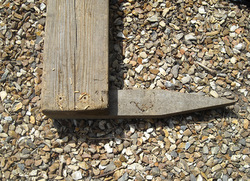How to make simple and strong raised beds for your garden
Posted by Fiona Nevile in General care, Save Money | 7 commentsOur cottage is set quite a way back from the road. We like this as it gives us a lot more privacy than a house set beside a pavement. This front garden faces south west and is a much warmer and more protected spot than the kitchen garden – which lies in a bit of a frost pocket.
Last year we extended the long south facing herbaceous border that runs from the gate to the cottage. This year we decided to use some more of the front drive for raised beds. Our drive is full of rocks and the soil is heavy clay – so raised beds seemed like a good idea.
If I was going to the palaver of making some raised beds, they had to be large and substantial. Some farming friends had made a series of rather nifty raised beds out of old rafters. Good solid beds that looked as if they’d last for years. This was back in my decorating days. When I spotted a pile of these rafters in one of their barns I bartered some painting for rafters and stakes.
Two years later I finally pulled my finger out and started to make the raised beds this week. The design is very simple, an 8’ square, 8” deep. The sides of a raised bed must be at least 6” deep and even deeper if you are planning to grow parsnips or anything that has long roots.
There are two key rules when making raised beds. Attach strong pointed stakes to two sides to make the beds firm and stable. The other sides butt up to these and are secured with long coach bolt screws – these have square tops so can be driven into place with an electric drill.
The other vital point is to make sure that each side is level and that the corners are square. If the ground isn’t completely flat this might take a bit of digging and jiggling around.
I couldn’t find the right length of coach bolts locally so as a semi temporary measure I used galvanised nails. Trying to force 5” nails through the rafters and into the oak stakes was impossible with an ordinary hammer so I wielded a fencing hammer with good, fast results.
Today we have been filling the first bed with Fenland soil. Beautiful stuff, dark and friable. We bought it from Madingley Mulch – and I reckon that it’s well worth the investment. Trying to improve the poor soil in the garden has been a real bane these past few years. Expensive too. We’re slowly getting there – the vegetables in the kitchen garden are looking much stronger and bigger this year.
My farming friends used potting compost to fill their raised beds. I reckon that this was a mistake as it just doesn’t have the welly to provide a really good growing medium year after year.
It’s great to have good soil to start with in the raised beds.
When the bed is filled with soil (leave at least 1.5” space at over the soil to avoid run off) water the soil well and leave for a day or so as to allow the watered soil to warm up. The soil will drop a little so fill up and rake smooth. By watering well before planting your plants will have a good reserve of water to draw on from the word go.
We have also discovered the joy of turning pallets into something even more useful. We have plans for a few smaller raised beds for yet more salad and samphire! These have to be well out of the way of boy racer reversing though.
Leave a reply








We’ve come to the same decision you have — raised beds are the way to go if your soil is crappy. Unfortunately, ours are going to be much uglier than yours, as we haven’t come across a convenient supply of old rafters (reclaimed lumber goes for a fortune around here).
Hi Fiona! I like the look of these. I’ve actually been meaning to ask you if you could recommend an online supplier for compost and soil amendments! I’ve started on our London clay this year, and buying the stuff in bags from the local garden centre is expensive and a hassle. I don’t want proper bulk quantities – no tonne of manure for me thank you – but would like to get hold of good quality, peat free compost. Suggestions from other commenters welcome too!
My husband is known as pallet-man amongst our friends here in France. He has built two chicken houses, a workshop extension to his garage and a raised strawberry bed for me already this year. We’re lucky that we seem to have a never ending supply of pallets thanks to our French neighbour.
You make it sound so easy, let’s see what happens when I try it! I’m sure it will amuse people – especially the OH who’s one for ‘getting someone to do it who knows what they are doing’.
My word what an impressive and professional job! I have a much sloppier approach – just get 4 beams and arrange them in a rough square or rectangle, no nails or fixings, fork the soil inside to break up the clay a bit and then fill it with compost, manure and a little sand. And the next year I move the beams somewhere else and start again, and dig the old compost etc into the soil. But I am thinking about making a permanent raised bed, and I will definitely follow your method.
Hi Fiona,
that is a huge raised bed, how will you plant/weed the center, without stepping on the soil? An arm’s length x2 (about 4ft) should be wide enough, because then you can reach the center from both sides.
I really enjoy reading your blog early in the morning while I’m drinking my coffee.
I have a very long back so I can sit on the side and easily reach the middle! I prefer a wider bed but will be making some slimmer ones too.